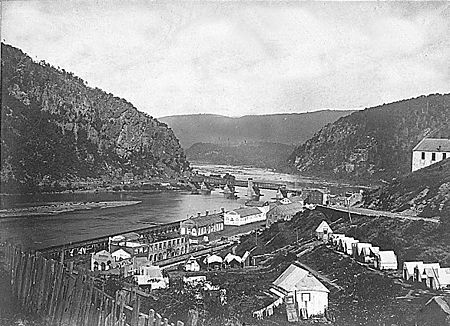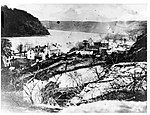Battle of Harpers Ferry

The Battle of Harpers Ferry was fought September 12–15, 1862, as part of the Maryland Campaign of the American Civil War. As Confederate Army General Robert E. Lee's Confederate army invaded Maryland, a portion of his army under Major General Thomas J. "Stonewall" Jackson surrounded, bombarded, and captured the Union garrison at Harpers Ferry, Virginia (now West Virginia). As Lee's Army of Northern Virginia advanced down the Shenandoah Valley into Maryland, he planned to capture the garrison at Harpers Ferry to secure his line of supply back to Virginia. Although he was being pursued at a leisurely pace by Major General George B. McClellan's Army of the Potomac, outnumbering him more than two to one, Lee chose the risky strategy of dividing his army and sent one portion to converge and attack Harpers Ferry from three directions. Colonel Dixon S. Miles, Union commander at Harpers Ferry, insisted on keeping most of the troops near the town instead of taking up commanding positions on the surrounding heights. The slim defenses of the most important position, Maryland Heights, first encountered the approaching Confederates on September 12, but only brief skirmishing ensued. Strong attacks by two Confederate brigades on September 13 drove the Union troops from the heights. During the fighting on Maryland Heights, the other Confederate columns arrived and were astonished to see that critical positions to the west and south of town were not defended. Jackson methodically positioned his artillery around Harpers Ferry and ordered Maj. Gen. A.P. Hill to move down the west bank of the Shenandoah River in preparation for a flank attack on the Federal left the next morning. By the morning of September 15, Jackson had positioned nearly 50 guns on Maryland Heights and at the base of Loudoun Heights. He began a fierce artillery barrage from all sides and ordered an infantry assault. Miles realized that the situation was hopeless and agreed with his subordinates to raise the white flag of surrender. Before he could surrender personally, he was mortally wounded by an artillery shell and died the next day. After processing more than 12,000 Union prisoners, Jackson's men then rushed to Sharpsburg, Maryland, to rejoin Lee for the Battle of Antietam.
Excerpt from the Wikipedia article Battle of Harpers Ferry (License: CC BY-SA 3.0, Authors, Images).Battle of Harpers Ferry
Shenandoah Street,
Geographical coordinates (GPS) Address Nearby Places Show on map
Geographical coordinates (GPS)
| Latitude | Longitude |
|---|---|
| N 39.3228 ° | E -77.7302 ° |
Address
Arsenal Square
Shenandoah Street
21758
West Virginia, United States
Open on Google Maps











